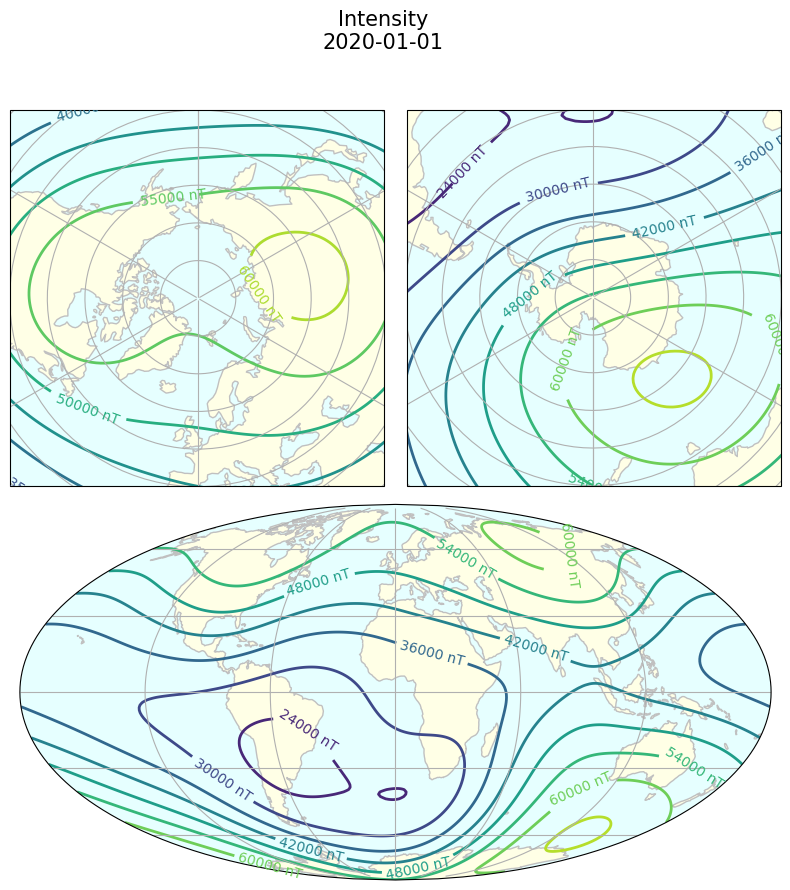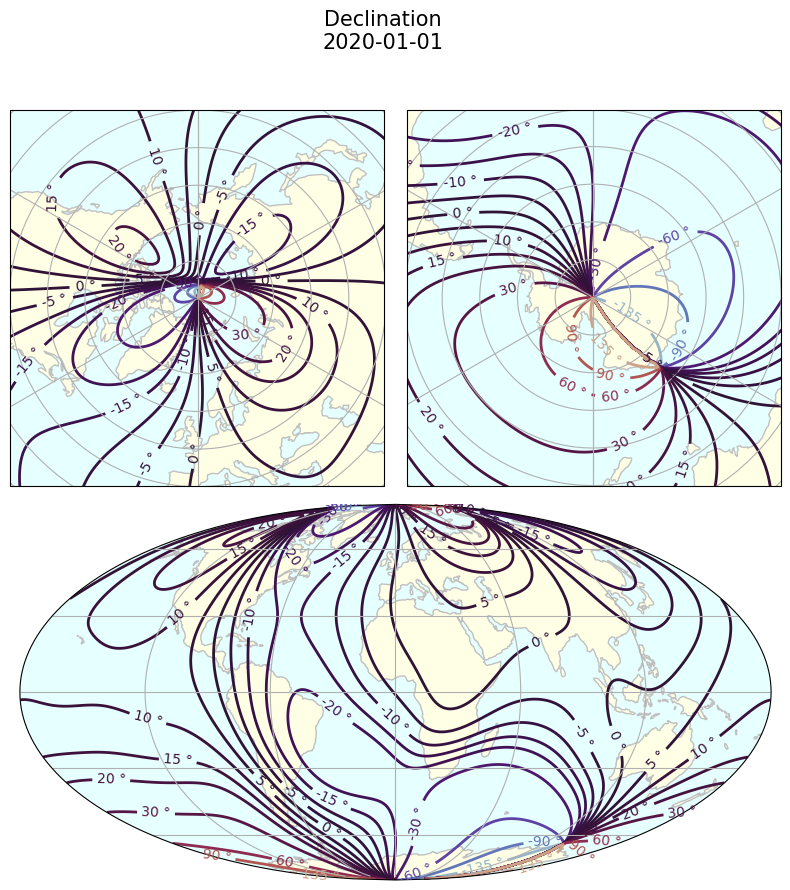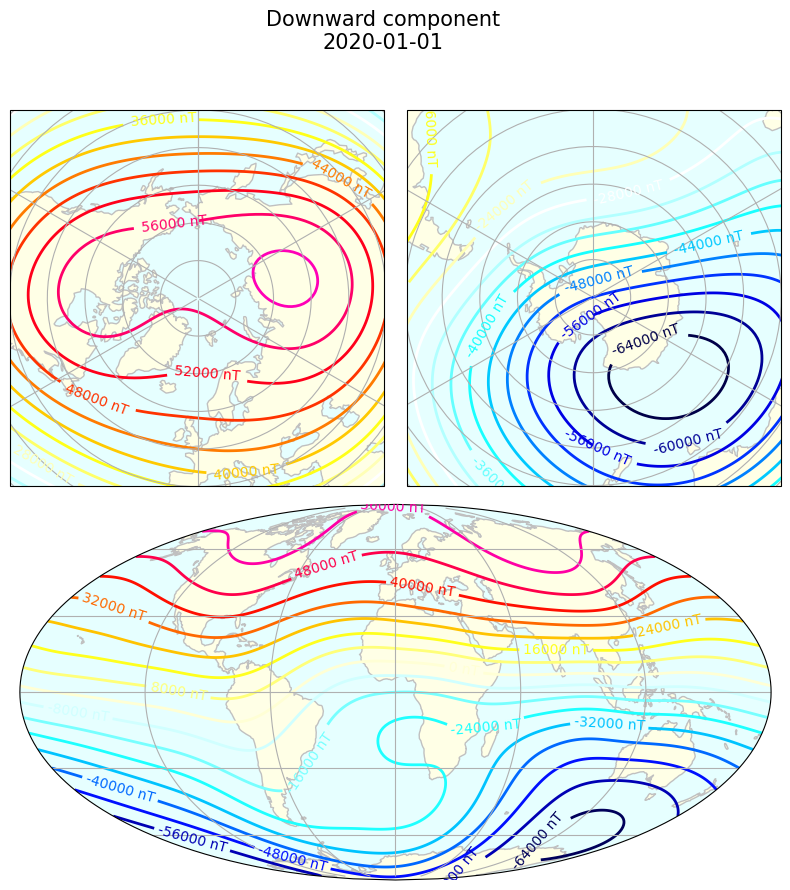Geomagnetic Models (eoxmagmod + contours)#
Abstract: Demonstrate basic usage of eoxmagmod for forwards evaluation of magnetic model, together with contour visualisations with cartopy.
eoxmagmod is used internally within VirES to perform the forward evaluations of geomagnetic models. This notebook is a demonstration of using it directly for the simple .shc file case, though it can also be used to evaluate the more complex models. There is not much documentation but we could work to improve this (and the installation and usability) if it is useful.
Here we show a basic setup of contour plots using cartopy. It would be good to build a richer set of preset visualisations as part of an importable library.
See also:
import os
if 'CI' in os.environ:
os.environ['CDF_LIB'] = '/srv/conda/envs/notebook/lib'
%load_ext watermark
%watermark -i -v -p viresclient,pandas,xarray,matplotlib,scipy,cartopy,eoxmagmod,chaosmagpy
Python implementation: CPython
Python version : 3.11.6
IPython version : 8.18.0
viresclient: 0.12.3
pandas : 2.1.3
xarray : 2023.12.0
matplotlib : 3.8.2
scipy : 1.11.4
cartopy : 0.22.0
eoxmagmod : 0.14.0
chaosmagpy : 0.14
import datetime as dt
import numpy as np
import matplotlib as mpl
import matplotlib.pyplot as plt
from scipy.interpolate import interp1d
import cartopy.crs as ccrs
import cartopy.feature as cfeature
import eoxmagmod
from chaosmagpy.plot_utils import nio_colormap
Functions to do the legwork of evaluation and plotting#
def grid(nlats=180, nlons=360):
"""A global grid of the specified size"""
_lats = np.linspace(-90, 90, nlats + 1)
_lons = np.linspace(-180, 180, nlons + 1)
coords = np.empty((_lats.size, _lons.size, 3))
coords[:,:,1], coords[:,:,0] = np.meshgrid(_lons, _lats)
coords[:,:,2] = 0 # height above WGS84 in km
return coords
def eval_model(time=dt.datetime(2020, 1, 1), coords=grid(),
shc_model=eoxmagmod.data.CHAOS_CORE_LATEST):
"""Evaluate a .shc model at a fixed time
Args:
time (datetime)
coords (ndarray)
shc_model (str): path to file
Returns:
dict: magnetic field vector components:
https://intermagnet.github.io/faq/10.geomagnetic-comp.html
"""
# Convert Python datetime to MJD2000
epoch = eoxmagmod.time_util.datetime_to_decimal_year(time)
mjd2000 = eoxmagmod.decimal_year_to_mjd2000(epoch)
# Load model
model = eoxmagmod.load_model_shc(shc_model)
# Evaluate in North, East, Up coordinates
height = eoxmagmod.GEODETIC_ABOVE_WGS84
b_neu = model.eval(mjd2000, coords, height, height)
# Inclination (I), declination (D), intensity (F)
inc, dec, F = eoxmagmod.vincdecnorm(b_neu)
return {"X": b_neu[:,:,0], "Y": b_neu[:,:,1], "Z": -b_neu[:,:,2],
"I": inc, "D":dec, "F":F}
def _plot_contours(ax, x, y, z, *args, **kwargs):
transform_before_plotting = kwargs.pop("transform_before_plotting", False)
if transform_before_plotting:
# transform coordinates *before* passing them to the plotting function
tmp = ax.projection.transform_points(ccrs.PlateCarree(), x, y)
x_t, y_t = tmp[..., 0], tmp[..., 1]
return ax.contour(x_t, y_t, z, *args, **kwargs)
else:
# ... transformation performed by the plotting function creates glitches at the antemeridian
kwargs["transform"] = ccrs.PlateCarree()
return ax.contour(x, y, z, *args, **kwargs)
def plot_contours(ax, x, y, z, *args, **kwargs):
fmt = kwargs.pop("fmt", "%g")
fontsize = kwargs.pop("fontsize", 6)
ax.add_feature(cfeature.LAND, facecolor=(1.0, 1.0, 0.9))
ax.add_feature(cfeature.OCEAN, facecolor=(0.9, 1.0, 1.0))
ax.add_feature(cfeature.COASTLINE, edgecolor='silver')
ax.gridlines()
cs = _plot_contours(ax, x, y, z, *args, **kwargs)
ax.clabel(cs, cs.levels, inline=True, fmt=fmt, fontsize=fontsize)
def _apply_circular_boundary(ax):
"""Make cartopy axes have round borders.
See https://scitools.org.uk/cartopy/docs/v0.15/examples/always_circular_stereo.html
Notes:
Inline contour labels are still appearing outside the boundary
"""
theta = np.linspace(0, 2*np.pi, 100)
center, radius = [0.5, 0.5], 0.5
verts = np.vstack([np.sin(theta), np.cos(theta)]).T
circle = mpl.path.Path(verts * radius + center)
ax.set_boundary(circle, transform=ax.transAxes)
def contours_NorthSouthMoll(coords, data, units, title, **options):
"""Generate trio of AzimuthalEquidistant (N/S) and Mollweide projections
Args:
coords (ndarray)
data (ndarray)
units (str)
title (str)
"""
# Set up figure with North/South/Mollweide maps
fig = plt.figure(figsize=(10, 10))
fig.suptitle(title, fontsize=15)
ax_N = plt.subplot2grid(
(2, 2), (0, 0),
projection=ccrs.AzimuthalEquidistant(
central_longitude=0.0, central_latitude=90.0,
false_easting=0.0, false_northing=0.0, globe=None
)
)
ax_S = plt.subplot2grid(
(2, 2), (0, 1), colspan=2,
projection=ccrs.AzimuthalEquidistant(
central_longitude=0.0, central_latitude=-90.0,
false_easting=0.0, false_northing=0.0, globe=None
)
)
ax_Moll = plt.subplot2grid(
(2, 2), (1, 0), colspan=2,
projection=ccrs.Mollweide()
)
ax_N.set_extent([-180, 180, 40, 90], ccrs.PlateCarree())
ax_S.set_extent([-180, 180, -90, -40], ccrs.PlateCarree())
# _apply_circular_boundary(ax_N)
# _apply_circular_boundary(ax_S)
# Plot on the contours from the given data
# Set options and update with any overrides provided
kwargs = {
"fmt": f"%g {units}",
"linewidths": 2,
"fontsize": 10
}
kwargs.update(options)
## Masks to select the northern and southern parts separately
# Notes:
# - the polar orthographic projection works only with all points
# within the maps extent (i.e., visible part of the globe).
north = (coords[:, 0, 0] > 0).nonzero()[0]
south = (coords[:, 0, 0] < 0).nonzero()[0]
# Northern and Southern Hemipshere plots
plot_contours(ax_N,
coords[north, :, 1], coords[north, :, 0], data[north, :],
transform_before_plotting=True, **kwargs)
plot_contours(ax_S,
coords[south, :, 1], coords[south, :, 0], data[south, :],
transform_before_plotting=True, **kwargs)
# Mollweide plot
plot_contours(ax_Moll,
coords[..., 1], coords[..., 0], data,
transform_before_plotting=False, **kwargs)
# fig.tight_layout()
fig.subplots_adjust(hspace=0.05, wspace=0.05)
return fig, [ax_N, ax_S, ax_Moll]
Perform the model evaluation#
t = dt.datetime(2020, 1, 1)
# You can supply your own shc file here
# Just set shc_model as the file path
shc_model = eoxmagmod.data.CHAOS_CORE_LATEST
coords = grid()
mag_components = eval_model(t, coords, shc_model)
mag_components.keys()
dict_keys(['X', 'Y', 'Z', 'I', 'D', 'F'])
The evaluated model vector components are stored as a dictionary, mag_components, so that you can access the X (Northwards) component as mag_components['X'] and so on, together with the matching coordinates stored in coords.
X: Northward, Y: Eastward, Z: Downward, I: Inclination, D: Declination, F: intensity
Generate plots#
contours_NorthSouthMoll(
coords, mag_components["F"], "nT",
f"Intensity\n{t.date()}");

# Options can be fed through to the underlying matplotlib calls
options = {
"levels": [-180, -135, -90, -60, -30, -20, -15, -10, -5, 0, 5, 10, 15, 20, 30, 60, 90, 135, 180],
"cmap": "twilight"
}
contours_NorthSouthMoll(
coords, mag_components["D"], "°",
f"Declination\n{t.date()}", **options);

contours_NorthSouthMoll(
coords, mag_components["Z"], "nT",
f"Downward component\n{t.date()}",
levels=20, cmap=nio_colormap());

